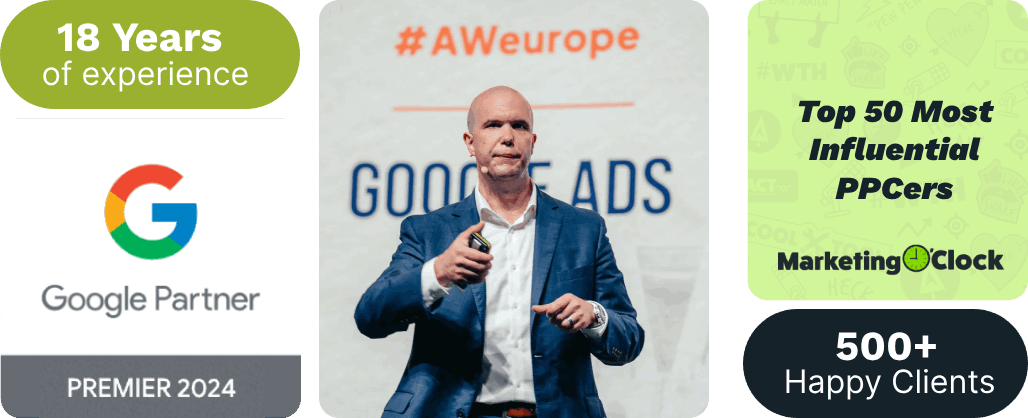Ever wish you could be a fly on the wall during a discussion between our expert Google Ads strategists? You’re in luck! Recently, Usama led an internal training session about a valuable top-of-funnel (TOF) marketing strategy that can help you scale your eCommerce campaigns to success.
In this video, he uses an example of a skin care client to demonstrate how focusing on cold traffic can be helpful once Brand campaign performance starts to decline. In a nutshell, shifting the focus to converting on cold terms is a great way to bring in more conversions and increase customer lifetime value (LTV).
Side note: The difference between cold and warm traffic has to do with how familiar a targeted buyer is with your brand and the products and/or services you offer. Cold search terms indicate they have little to no information about your business but are simply searching for a product or solution they need, whereas a warm search term would likely contain your brand name.
Let's dive in.
Usama begins by using a common cold search term people often use for skin care: vitamin C serum. (Other examples are retinol serum and best face wash, neither of which is tied to a particular brand.) Usama explains that he typically recommends splitting the campaigns and getting rid of Brand for the purpose of this strategy, and he shows how it should work in the video.

The example campaign was launched on July 18th, and no changes were made except for a budget increase on July 31st because the client wanted to scale. Other than that, the campaign was not touched, but conversions are on the rise—which is exactly what we want.
In addition, says Usama, we always run these campaigns on low tROAS so there is enough space for Google to learn. If we set our tROAS too high, he explains, it restricts itself and we end up with a finite audience and the campaign eventually starts to die. However, when you use a low tROAS, you may have one or two bad weeks but it will recover and you will end up getting way more conversions.
As Usama says, “Trust the process. Just go for it.”
A common assumption about branded terms
Usama goes on to say that one of the biggest assumptions people tend to make about branded terms is that people already know of the brand because of the vast amount of marketing done on Facebook, Instagram, etc. and that they are coming back via Google searching for the brand to convert.
Technically, yes, those are new customers, but the majority of the time they are not Google effort customers. In other words, “I didn’t put in the work for it, I just took the credit for it because it’s a branded conversion,” says Usama. “But then there are situations where people search for random cold terms and convert for us,” which he explains is what’s happening in the example campaign.

So, Usama goes on to say, when we look at what converted for us in terms of terminology, it doesn’t get any colder than this in terms of someone who does not know your brand. And, the team agrees it’s a fair assumption to make that almost everyone that’s converted here is going to be a new customer that just found our brand, clicked our ad, and bought from us.
Next, Usama takes a look at the Northbeam numbers for the campaign, specifically first-time and return customers for the last 28 days. Comparing it with Google Ads, we see 356 first-time transactions in TOF and 42 return transactions from the TOF campaign. These are likely customers already familiar with the brand who were then searching for a different product that they didn’t know that brand carried, and then bought from that brand again.
So, this is someone that came in from a cold term initially, but then searched a cold term again, saw that the brand had the product, and bought from that brand.
Is that good or bad?
In Usama’s opinion, it’s good, and it has to do with LTV.
He explains it like this: “Let’s say you bought said product #1—and this is skin care products, so people are going to re-buy, right?—and the LTV for my first product is $100 then all of a sudden you find out that there’s another product you like using and you also buy this product too, and the LTV for that product is $150.” So, your customer LTV suddenly went from $100 to $250, which is great.

As with most strategies, there are caveats.
Sometimes it comes down to how often people return and buy, and our strategists did the math and determined there was about a 10% overlap. In other words, out of all the cold transactions, 10% of the people that are converting on cold turns did not know that we had another set of products that they wanted.
In Usama’s opinion, 10% is a good value in the skin care industry because usually people have multiple skin care brands and products in their routine.
Where this may fail, he admits, is when you have a lot of return customers coming in to buy other products from cold traffic because they didn’t know of the product. If the business is not doing enough to educate consumers that they carry other products, the ratio may start to get worse and that’s when things may start to fizzle out.
Need to see the numbers for yourself? Watch the full video here.
Author
Pamela is the Senior Content Writer at Solutions 8. When she's not writing, you can find her hiking in the woods with her dogs. She is currently on a quest to visit every national park in the United States.
 Pamela Sapio
Pamela Sapio











